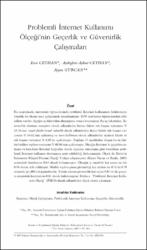| dc.contributor.author | Ceyhan, Esra | |
| dc.contributor.author | Ceyhan, Aydoğan Aykut | |
| dc.contributor.author | Gürcan, Ayşen | |
| dc.date.accessioned | 2019-10-19T19:56:18Z | |
| dc.date.available | 2019-10-19T19:56:18Z | |
| dc.date.issued | 2007 | |
| dc.identifier.issn | 1303-0485 | |
| dc.identifier.uri | http://www.trdizin.gov.tr/publication/paper/detail/TnpFMk9EVTE= | |
| dc.identifier.uri | https://hdl.handle.net/11421/14860 | |
| dc.description.abstract | Bu araştırmada, üniversite öğrencilerinde problemli İnternet kullanımını belirlemeye yönelik bir ölçme aracı geliştirmek amaçlanmıştır. 1658 üniversite öğrencisinden elde edilen veriler, ölçeğin üç faktörden oluştuğunu ortaya koymuştur. Bu üç faktörden, İnternet'in olumsuz sonuçları olarak adlandırılan birinci faktör tek başına varyansın % 25,36'sını, sosyal fayda/sosyal rahatlık olarak adlandırılan ikinci faktör tek başına varyansın % 14,62'sini açıklamış ve aşırı kullanım olarak adlandırılan üçüncü faktör ise tek başına varyansın % 8,98'ini açıklamıştır. Toplam 33 maddeden oluşan bu üç faktör birlikte toplam varyansın % 48,96'sını açıklamıştır. Ölçeğin İnternet'te geçirilen zamana ve kendisini İnternet bağımlısı olarak algılama durumuna göre bireylerin problemli İnternet kullanım davranışını ayırt edebildiği bulunmuştur. Ölçek ile Davis'in İnternette Bilişsel Durum Ölçeği Türkçe adaptasyonu (Keser Özcan ve Buzlu, 2005) arasındaki korelasyon 0.61 olarak bulunmuştur. Ölçeğin iç tutarlılık kat sayısı ise (.) 0.94 olarak elde edilmiştir. Madde toplam puan güvenirliği kat sayıları ise 0.31 ile 0.70 arasında (p<.001) değişmektedir. Testin tekrarı güvenirlik kat sayısı 0.81 ve iki parçası arasındaki korelasyon 0.83 olarak bulunmuştur. Böylece, “Problemli İnternet Kullanım Ölçeği” (PİKÖ) olarak adlandırılan ölçek ortaya çıkmıştır. | en_US |
| dc.description.abstract | In this research, it was aimed to develop an instrument for determining problematic internet usage of university students. Factorial structure of the data collected from 1658 university students revealed three factors. Of these, the first factor is called negative consequences of the internet and accounted for 25.36% of the variance, the second factor is called social benefit / social comfort and accounted for 14.62% of the variance, and the third factor is called excessive usage and explained 8.98 % of the variance. All three factors consisting of 33 items accounted for the 48.96% of the total variance. It was found that the scale was able to discriminate problematic internet use with respect to the time spent on the internet and individuals' perception of themselves as the internet addicts. The correlation between the scale and the Davis's Online Cognitive Scale-Turkish adaptation (Keser Özcan ve Buzlu, 2005) was found as 0.61. Internal consistency coefficient of the scale (.) was found to be 0.94. Item total correlations ranged between 0.31 and 0.70 (p>.001). Test-re-test reliability coefficient was found to be 0.81 and split half reliability coefficient was found to be 0.83. Thus, the scale called as the Problematic Internet Usage Scale&#8221; was developed. | en_US |
| dc.language.iso | tur | en_US |
| dc.rights | info:eu-repo/semantics/openAccess | en_US |
| dc.subject | Eğitim | en_US |
| dc.subject | Eğitim Araştırmaları | en_US |
| dc.title | Problemli İnternet Kullanımı Ölçeği'nin Geçerlik ve Güvenirlik Çalışmaları | en_US |
| dc.title.alternative | The Validity and Reliability of the Problematic Internet Usage Scale | en_US |
| dc.type | article | en_US |
| dc.relation.journal | Kuram ve Uygulamada Eğitim Bilimleri | en_US |
| dc.contributor.department | Anadolu Üniversitesi, Eğitim Fakültesi, Eğitim Bilimleri Bölümü | en_US |
| dc.identifier.volume | 7 | en_US |
| dc.identifier.issue | 1 | en_US |
| dc.identifier.startpage | 387 | en_US |
| dc.identifier.endpage | 416 | en_US |
| dc.relation.publicationcategory | Makale - Ulusal Hakemli Dergi - Kurum Öğretim Elemanı | en_US] |
| dc.contributor.institutionauthor | Ceyhan, Esra | |
| dc.contributor.institutionauthor | Ceyhan, Aydoğan Aykut | |


















